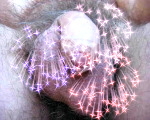|
|
|
|
|
|
|
 |
|
testicular
self examination
|
|

|
| |
|
|
|
|
Testicular
Self Exam (TSE)
What
is TSE and why should men do it?
TSE is a simple and effective way for men to recognize the early signs
and symptoms of testicular cancer. Testicular cancer is one of the
most frequently occurring types of cancer in men ages 18 to 35 and can
occur anytime after the age of 15. And if it is caught early,
testicular cancer is one of the most curable forms of cancer.
What
are the risk factors for testicular cancer?
There is evidence that the risk of testicular cancer is higher in men
whose testicles did not descend normally. That means that during
childhood development the testicles did not move down from the lower
abdomen into the scrotum. For this reason, surgery is often performed
to correct this problem before the testicle has been left undescended
for very long.
According
to the National
Cancer Institute, a man's race/ethnic background can be
another risk factor. The incidence rate (out of 100,000) for
testicular cancer is 6.5 for White men; 3.4 for Latino men; 2.6 for
American Indian/Alaskan Native men; 2.1 for Asian/Pacific Islander men
and 1.2 for African American men. The reason for different incidence
rates is unknown and continues to be researched.
Other
risk factors for testicular cancer include:
- Family
history
- Occupational
risks
- Cancer
of the other testicle
- Injury
to the testicles
- HIV
infection
When
should I perform TSE and how often?
TSE should be performed once a month after a warm bath or shower. The
heat causes the scrotal skin to relax, making it easier to find
anything unusual. The procedure itself is simple and should only take
a few minutes. It may help you to remember to do TSE if you choose a
date each month that's easy to remember like your birth date or the
first of each month. Performing TSE on a regular basis will allow you
to become familiar with the size and feeling of your testicles and can
help you detect any changes if they occur.
How
do I perform TSE and what am I looking for?
TSE is simple to perform and can quickly become a part of your
routine. You can also ask your partner if they would perform TSE for
you.
- Examine
each testicle separately.
- Using
both hands, put your thumbs on top of the testicle and the pads of
your fingers under and behind the testicle.
- Gently
slide or roll the skin of the scrotum across the testicle. Do not
rub.
- Examine
the entire area of the testicle. The surface should feel smooth,
without lumps or tenderness.
- Feel
the side of the testicle closest to the body for the epididymis.
The epididymis is a comma-shaped, cord-like tube that stores and
transports sperm. Don't mistake the "lump" of the
epididymis for an abnormal lump. Cancerous lumps are more commonly
found at the front of the testicle. If you're not sure if you have
felt the epididymis or a lump, make an appointment at Health
Services. You can request a male medical provider if you would be
more comfortable being examined by a man.
It
is normal for a man's testicles to be different sizes, and for one to
hang lower and a bit behind the other. The scrotum regulates the heat
of the testicles by relaxing and lowering the testicles away from the
body when they are warm, and contracting and pulling the testicles up
close to the body when they are cold. This temperature regulation is
necessary for sperm production.
When
performing TSE you are looking for:
- Small,
hard, non-tender lump or nodule in the testicle
- Enlarged
testicle and/or a feeling of extra heaviness in the testicle
- Change
in the way the testicle feels or in its consistency
- Dull
ache in the lower abdomen or groin.
-
What
does it mean if I find a lump?
Lumps are not always cancer. However, if you notice a lump,
enlargement, tenderness or other unexplained changes in your
testicles, talk to your medical provider right away. Brown students
can make an appointment at Health Services (401.863-3953) and you can
request a provider by gender or by name. The change may be a sign of
infection in the testicle (epididymitis) or of testicular torsion (a
condition in which the testicle becomes rotated inside the scrotum and
becomes "strangulated," which cuts off the blood supply. If
left uncorrected, this can result in the loss of a testicle).
If
you are diagnosed with testicular cancer, the good news is that it is
more than 95% curable when detected and treated early. However,
testicular cancer may spread rapidly if detection and treatment is
delayed.
Testicular cancer almost always occurs in only one testicle. Only 2%
of men diagnosed with testicular cancer will develop a new tumor in
the other testicle. Because the testes do not readily take in
anticancer drugs, treatment of testicular cancer typically
necessitates surgical removal of the affected testicle. While this
thought makes most men apprehensive, be assured that one healthy
testicle is sufficient for full sexual and reproductive function.
Should
I make an appointment to get a testicular exam?
It's recommended that healthy men under age 40 have a testicular exam
by a medical provider every 1 to 2 years.
Check
"safer sex tips" enjoy
life play safer
>>>
top <<<
|